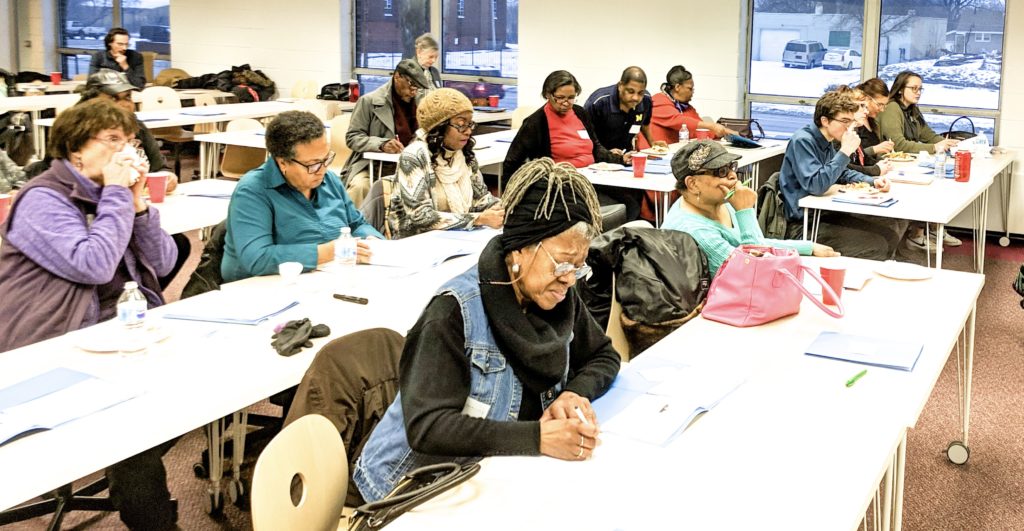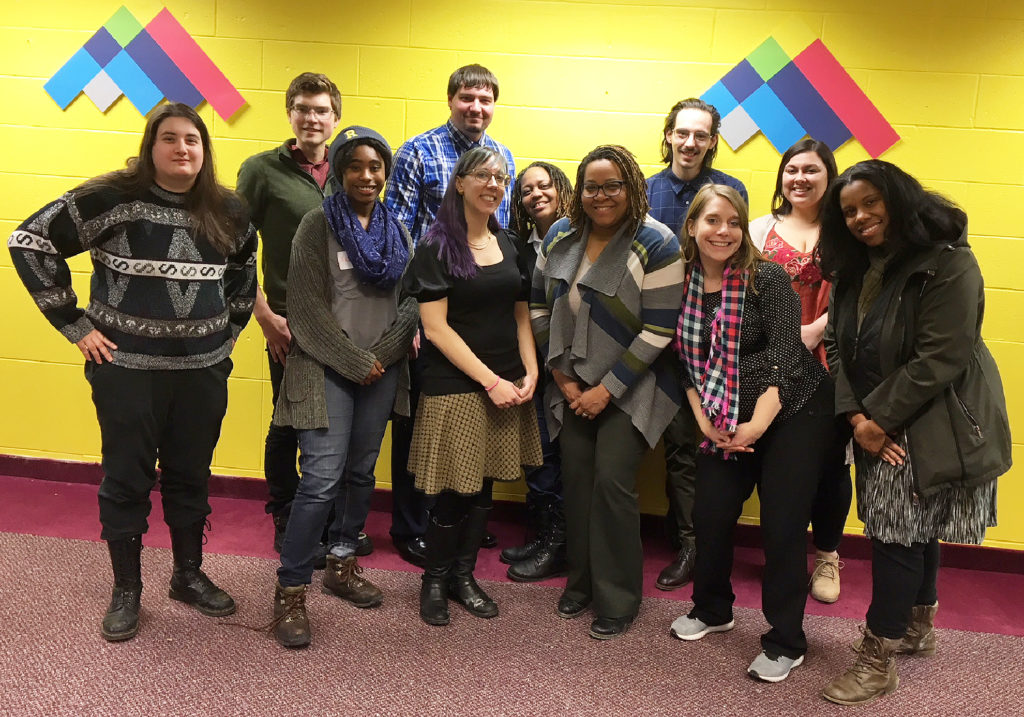By Meghan Christian and Patsy Isenberg
To suggest how neighborhood leaders might figure out which problems to focus on, Carma Lewis of Flint Neighborhoods United offers a practical lead.
“I start with what I can see outside my window, because that’s my domain that I have control over,” she told a group of about 25 at the first “Neighbors Changing Flint” workshop Feb. 20.
The “Neighbors Changing Flint” series has returned for its second year. The six-week long program aims to help residents become more informed on how to engage in and improve their neighborhoods.
Sessions are held every Wednesday evening until March 27 from 5 to 8 p.m. at the Sylvester Broome Empowerment Village, located at 4119 Saginaw St. Residents looking to attend must register by calling 810-620-1299, ext. 2 or via email at director@neighborhoodengagementhub.org.

Participants at the first “Neighbors Changing Flint” workshop Feb. 20 (Photo by Meghan Christian)
The series is hosted by the Neighborhood Engagement Hub in partnership with the Ruth Mott Foundation, Applewood, Flint Neighborhoods United, the City of Flint, the Crim Fitness Foundation, the Land Bank of Genesee County, and the Community Foundation of Greater Flint.
“We’re hoping residents are able to gather some ideas, resources and contacts for different types of projects they can apply to their neighborhoods,” Ashley Everhart, agency director of the Neighborhood Engagement Hub, said.
New format stresses breakouts, choices
Those familiar with the series from last year can expect not only just a change in venue from Asbury Church on Davison Road to the Sylvester Broome Empowerment Village, but a change in the methodology of the series.
According to Everhart, last year’s sessions followed more of a single-instruction format, whereas the workshops this year will feature breakout sessions at each, where residents will be able to choose which they would like to attend upon arriving.
“The most significant challenge last year was keeping everyone engaged throughout the whole time, which is why we switched to holding breakout sessions,” Everhart explained. “That change in format seemed to better facilitate dialogue and networking,” she added.
At the Feb. 20 session, breakout sessions were facilitated by various neighborhood leaders such as Carma Lewis from Flint Neighborhoods United (FNU), Theresa Roach from the Crim Fitness Foundation, and others.
Basics of starting a group
Lewis, who discussed the basics of starting a group, reminded those in her breakout session that residents looking to get involved don’t need to look far. “I start by looking out my window,” Lewis said when describing how she goes about finding problems in her community. “Talk to your neighbors,” she added. Lewis reminded attendees there is an interactive map on the FNU site where residents can find active neighborhood groups in their area. Find the map here:https://www.flintneighborhoodsunited.org/flint-neighborhoods-map/
Regardless of how a group forms, Lewis urged residents creating new groups to consider the various ways they communicate with their members, reminding them that not all Flint residents use email or have access to a phone. “Do what works for you, but keep those lines of communication open,” Lewis said.

Blight workshop presenters: (front row l-r) Alexandria Brown, Lindsay Crawford, Theresa Roach, Ashley Everhart, Ange’le Johnson. (Back row l-r) Amanda Rolfes, Zach Hayes, John Cohoon, Carma Lewis, Michael Lawlor, Alyssa Olivarez.
Second workshop: blight elimination
An overview of the City of Flint’s Blight Court, tips on how to conduct a survey, and suggestions for using landscaping, lighting, pathways, entrances, signs and barriers to prevent crime were among the topics covered at the second “Neighbors Changing Flint” workshop Feb. 27 at the Sylvester Broome Empowerment Village.
About 30 residents attended. Ashley Everhart, dMichael Lairector of the Neighborhood Engagement Hub, began with an introduction to that night’s format after residents munched on the sandwiches, salad, cookies and sodas. She explained what blight is and emphasized that making improvements in Flint neighborhoods would be a significant step in beautifying the city.
Two breakout sessions of 45 minutes each covered two topics each. Attendees chose which topics interested them most. Packets provided contained information on the topics covered including other agencies that could provide support for blight elimination efforts.
Neighborhood surveys
Michael Lawlor from the City of Flint Planning & Zoning Division covered tips for how to conduct a neighborhood survey. The surveys are done by a two or three-person team, a driver and a data collector, volunteers who have attended a training session. The team uses a map and a mobile device to put the information on the property portal which anyone can access at flintpropertyportal.com. According to Lindsay Crawford from City of Flint Blight Elimination Division, that site has the most up-to-date information and she uses it frequently.
Blight Court
Crawford provided information about the recently created Blight Court. The Blight Court’s goal is to follow up on tickets given to residents whose properties have been identified as needing work. If the work isn’t done by an established time frame the fine increases and the offender might have to appear in Blight Court. Crawford said the hope is this will encourage people to make the improvements required. Each ward in the city has been assigned a Neighborhood Safety Officer allowed to issue tickets. A representative who works at the court, Alyssa Olivarez, provided information about how the court works and how to go about reporting a violator of blight offenses.
Landscaping and barriers can help
John Cohoon from Applewood Estates and Crawford from the city’s Blight Elimination Division explained ways to reduce blight such as landscaping and barriers. One of the handouts in the packet detailed these ideas, suggesting that “A lot that looks cared for is less likely to be mistreated than one that looks vacant.”
Describing Crime Prevention Through Environmental Design (CPTED). Michael Lawlor explained that implementing CPTED guidelines discourages dangerous situations. Lawlor provided tips on landscaping, lighting, pathways, entrances, signs and barriers that can make a big difference. Keeping tree limbs at six feet or higher and shrubs three feet or lower produces natural surveillance enabling property owners “to see and be seen,” he said. See-through fencing also contributes.
Overall the “Neighbors Changing Flint” series has been viewed as a success to the staff of the Neighborhood Engagement Hub. “The sessions have been great both years,” Everhart said. “We’ve found that participants have enjoyed the sessions and have gotten a lot out of participating in them,” she added.
Schedule of remaining workshops–all 5-8 p.m. Sylvester Broom Empowerment Village, 4119 N. Saginaw St., Flint.
March 6: “Vacant Lot Reuse Strategies
March 13: Funding Opportunities
March 20: Promoting Health Through Neighborhood Design
March 27: Planning for Long Term Change
To attend any of these events email director@neighborhoodengagementhub.org or call 810-620-1299, ext 2.
EVM Managing Editor Meghan Christian can be reached at meghan.christian22@gmail.com. EVM staff writer Patsy Isenberg can be reached at pisenber@gmail.com.


You must be logged in to post a comment.